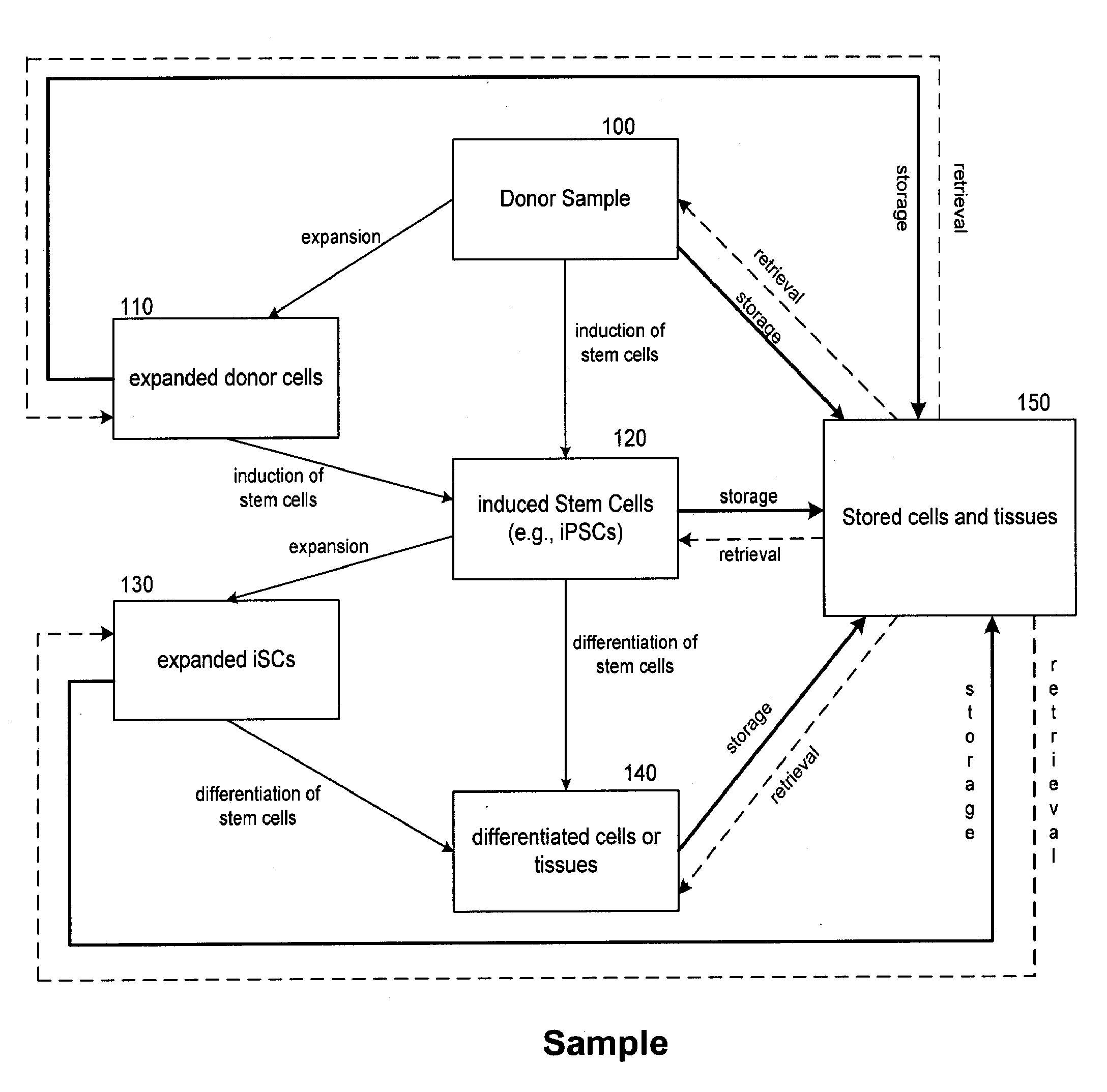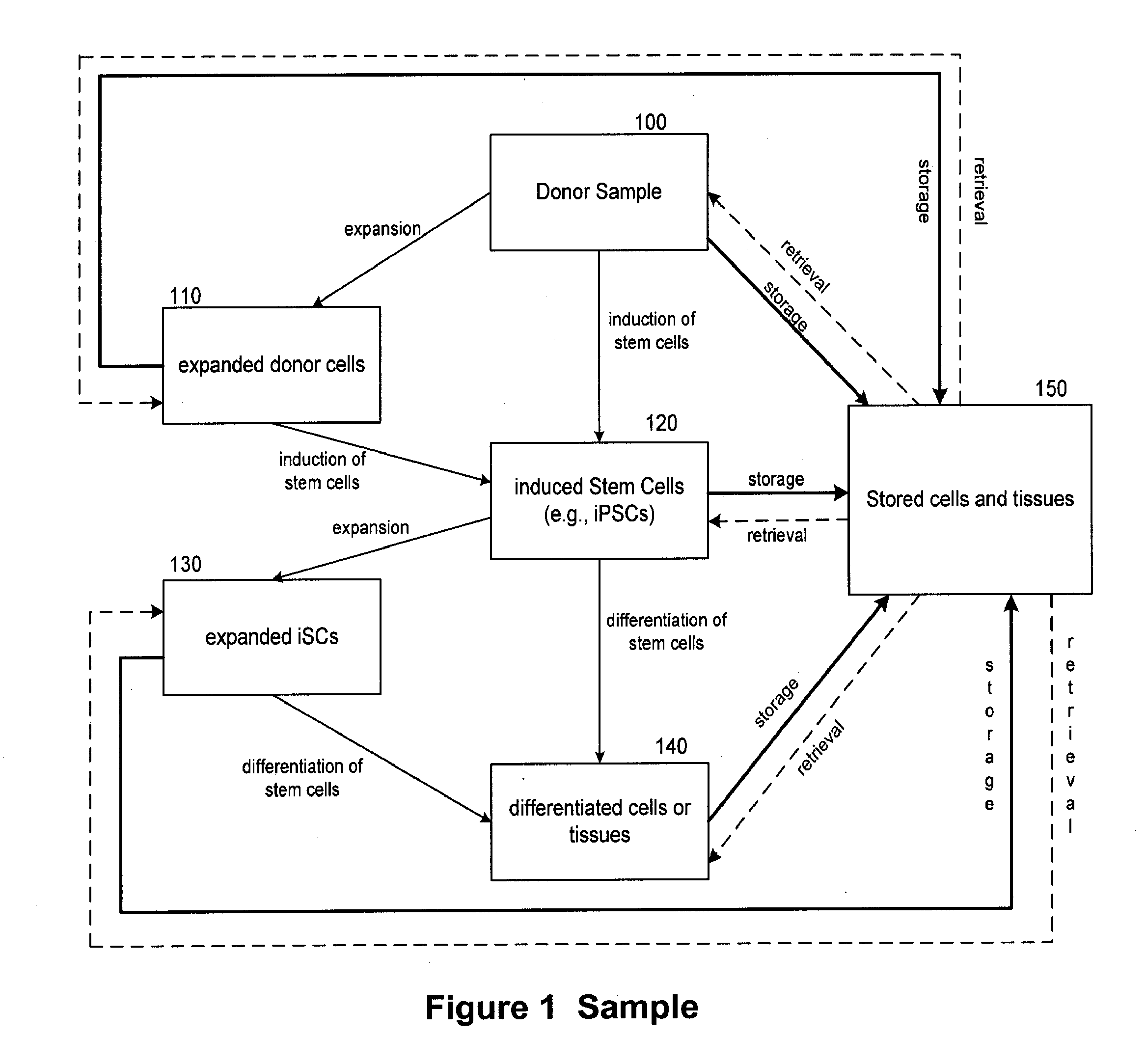Methods of cell-based technologies
a cell-based technology and technology of methods, applied in the field of cell-based technology, can solve problems such as hindering the progress of such therapies
- Summary
- Abstract
- Description
- Claims
- Application Information
AI Technical Summary
Benefits of technology
Problems solved by technology
Method used
Image
Examples
##ic example 1
Prophetic Example 1
[0189]This example illustrates the use of the products and services of the regenerative medicine business by a customer, herein referred to as subject A. Subject A first provides a biological sample, which is stored cryogenically by the regenerative medicine business. Optionally, induced pluripotent stem cells (iPSCs) may be derived from the biological sample by forcing the expression of induction factors such as Oct3 / 4, Sox2 and Klf4. The cells are induced to become pluripotent by following any method known in the art, e.g., a method described in U.S. application Ser. No. 12 / 157,967, filed Jun. 13, 2008, WSGR Docket Number 36588-704.201; First Inventor Kazuhiro Sakurada, or in WSGR Docket Number 36588-704.501, filed Jun. 12, 2009. Such iPSCs are then cryogenically stored for later use. At a later point in time, subject A suffers organ damage via liver failure. Subject A is deemed by those skilled in the art to require a liver transplant. Ordinarily, a liver trans...
##ic example 2
Prophetic Example 2
[0192]This example illustrates the use of the products and services of the regenerative medicine business by a customer, herein referred to as subject B. Subject B does not provide a sample to the regenerative medicine business. In this case, subject B also suffers liver failure due to trauma, and requires a transplant for which a suitable donor cannot be timely found. Subject B's physician obtains a kit provided by the regenerative medicine business for acquiring a suitable sample of biological material from subject B and transporting the sample to the regenerative medicine business. Upon receipt of the sample by the business, cells are analyzed, cultured and expanded. On the basis of donor and sample analysis, subject B is considered free of known diseases or conditions. A portion of expanded cells are stored cryogenically in individual aliquots for future use. A portion of expanded cells are also used to generate liver stem cells, which are then provided in the...
##ic example 3
Prophetic Example 3
[0193]This example illustrates the use of the products and services of the regenerative medicine business by a customer herein referred to as subject C. Subject C does not provide a sample to the regenerative medicine business. In this case, subject C suffers from a hereditary leukemia rendering an autologous transplant inadvisable because any autologous material contains the same hereditary factor that contributed to the leukemia.
[0194]Subject C's high resolution HLA type is determined by methods described herein from a sample of biological material, which is subsequently stored. The database of the regenerative medicine business is then searched to find an HLA serotype (low resolution HLA-type) match. Potential matches are then ranked according to donor and sample characteristics such as age of the donor (cells from younger donors are preferable), race or ethnic background of the donor (individuals of similar race or ethnic background are likely to have similar ...
PUM
| Property | Measurement | Unit |
|---|---|---|
| concentration | aaaaa | aaaaa |
| concentration | aaaaa | aaaaa |
| concentration | aaaaa | aaaaa |
Abstract
Description
Claims
Application Information
 Login to View More
Login to View More - R&D
- Intellectual Property
- Life Sciences
- Materials
- Tech Scout
- Unparalleled Data Quality
- Higher Quality Content
- 60% Fewer Hallucinations
Browse by: Latest US Patents, China's latest patents, Technical Efficacy Thesaurus, Application Domain, Technology Topic, Popular Technical Reports.
© 2025 PatSnap. All rights reserved.Legal|Privacy policy|Modern Slavery Act Transparency Statement|Sitemap|About US| Contact US: help@patsnap.com



